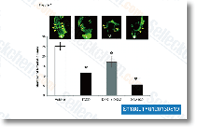Since the presence of InterPro domains is often a powerful indication of coding sequences, these information stage out that 64. 35% on the coelacanth de novo assembled contigs are coding for proteins characterized by recognized InterPro domains. Divergence involving the 2 coelacanth species The evolutionary divergence among the 2 species of coelacanth has become a subject of debate to get a long time. Whilst the full sequencing of mitochondrial DNA highlighted a sequence identity of 96%, variable divergence instances have been proposed, ranging from 6 to 40 Mya. The sequencing in the genome of L. chalumnae permitted to extend the comparison to big genomic re gions with all the obtainable BACs of L. menadoensis, eviden cing an identity of 98. 7%.
Our transcriptomic data provided the chance to assess the sequence identity inside the coding regions, which resulted to become remarkably high, standing at CHK1 inhibitor 99. 73%. However, whilst the huge level of infor mation gathered permits a rather quick calculation of diver gence costs, the estimate of divergence time isn’t such a trivial job, provided the uncertainties related for the calibration of the molecular clock, the slow generation time, the ab sence of other closely associated living species, as well as al legedly minimal charge of molecular evolution of coelacanths. While the two the genic and genomic divergence be tween the 2 species are much like these observed be tween human and chimp, which diverged six 8 Mya, we also performed a phylogenomic comparison in between coelacanths and T. rubripes/T.
nigroviridis, two organisms by using a absolutely sequenced genome, which evolved in an purchase AMN-107 aquatic setting and had been subject to somewhat simi lar selective pressure and whose divergence, based mostly on paleontological proof, is estimated amongst 32. 25 and 56 Mya. Based about the alignment of about forty Kb of ortholog transcribed sequences in Latimeria, we es timated the substitution rate for being 0,49/100 bp, whereas the substitution fee while in the exact same set of picked genes within the Takifugu/Tetraodon pair was roughly sixteen occasions larger. An easy molecular clock correlation would indicate the dating of divergence between African and Indonesian coelacanth must be positioned amongst one. 9 and three. 3 Mya. However the slower price of molecular evolution, as well as the considerably longer generation time need to be taken under consideration, most likely moving the divergence time much back in time to a date near to the reduced end from the estimates based mostly on mitochondrial DNA.
TEs discussion In metazoans repeat elements cover a considerable part of genomes. Furthermore, the transcriptome examination allowed the evaluation of the transcriptional activity of transposable el ements which play a essential position in gene evolution and genome plasticity. TEs are divided in two lessons, Class I is composed of Lengthy Terminal Repeat retrotransposons and Non LTRs, Class II is  composed of DNA transposons.
composed of DNA transposons.
Cd Antigens
The CD4 and CD8 antigens are coupled to a protein-tyrosine kinase (p56lck) that phosphorylates the CD3 complex.
